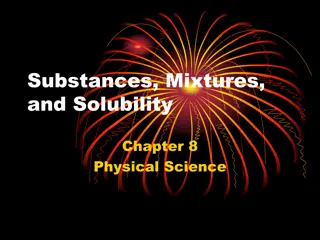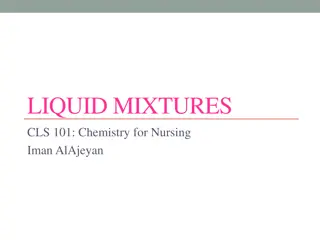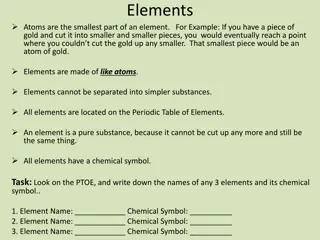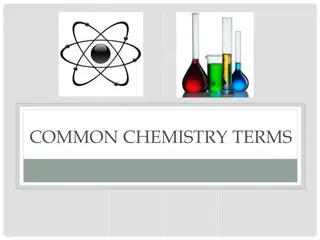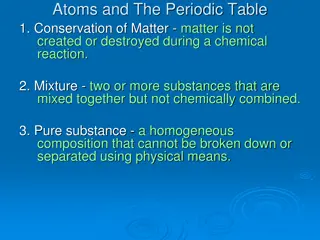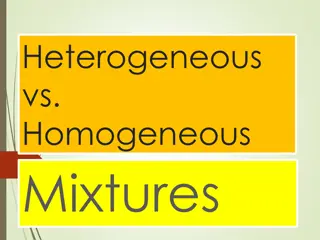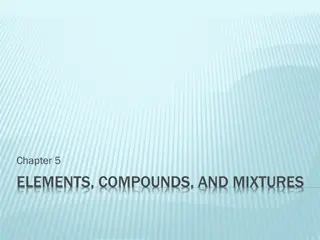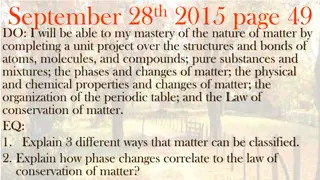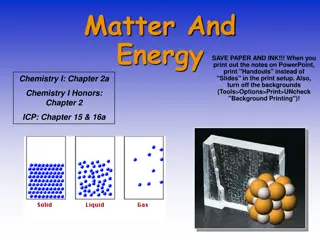Fundamentals of Chemistry: Matter, Mixtures, and Data Organization
Explore the basics of chemistry including precision vs. accuracy, organizing scientific data with graphs and tables, direct vs. inverse proportion, and the classification of matter into pure substances, compounds, and mixtures. Delve into the concepts of elements, atoms, and the properties of compounds. Understand the differences between heterogeneous and homogeneous mixtures in this informative overview.
Download Presentation

Please find below an Image/Link to download the presentation.
The content on the website is provided AS IS for your information and personal use only. It may not be sold, licensed, or shared on other websites without obtaining consent from the author. Download presentation by click this link. If you encounter any issues during the download, it is possible that the publisher has removed the file from their server.
E N D
Presentation Transcript
Chemistry: The Basics MR. CONKEY PHYSICAL SCIENCE CHAPTER 2
A few things first Precision V.S. Accuracy Precision the gauge of how exact a measurement is. Significant Figures all the digits that are known in a measurement, and the last digit that is estimated. Accuracy the closeness of a measurement to the actual value that is being measured.
Organizing Scientific Data: Types of Graphs Tables: simplest way to organize data. Line graphs useful for showing changes occurring in related variables. (e.g. change in temperature over time). Line graphs use slope = Rise/Run.
Direct V.S. Inverse Proportion Direct Proportion Inverse Proportion
Bar and Pie (Circle) Graphs Bar Graphs used to compare several measurements (data). Pie (or circle) graphs used to show how a part of something relates to the whole. Pie Graph 1st Qtr 2nd Qtr 3rd Qtr 4th Qtr
Classification of Matter Matter a small amount of the Universe that has both volume and mass and takes the form of a solid liquid or gas (the three states of matter on Earth). Pure Substances matter that always has exactly the same composition. What are some examples? Elements a substance that cannot be broken down into simpler substances. Atoms the smallest particle of an element.
Compounds Compound a substance that is made from two or more simpler substances and can be broken down into those simpler substances. (examples?) They differ from the substances that make them up. Properties change when elements join together to make compounds (example: silicon dioxide). Compounds always contain two or more elements joined in a fixed proportion.
Mixtures They tend to retain some properties of their individual substances that make them up, but their properties are less constant than the properties of a substance. Properties of mixtures can vary because the composition of a mixture is not fixed. Mixtures are classified by how well the parts (substances) are distributed throughout the mixture.
Heterogeneous V.S. Homogeneous Mixtures Heterogeneous Mixture In a Heterogeneous mixture the parts of the mixture are noticeably different from one another. Homogeneous Mixture In a Homogeneous the substances are so evenly distributed that it is difficult to distinguish one substance in the mixture from another. It appears to contain only one substance. Comes from the Greek words hetero and genus meaning different and kind
Mixture Classification A mixture can be classified as a solution, a suspension, or a colloid based on the size of its largest particles. Solution When substances dissolve and form a homogeneous mixture. (examples?) Suspension a heterogeneous mixture that separates into layers over time. Colloid contains some particles that are intermediate in size between the small particles in a solution and the larger particles in a suspension. They do not separate into layers.
Physical Properties A physical property is any characteristic of a material that can be observed or measured without changing the composition of the substances in the material. Viscosity, conductivity, malleability, hardness, melting point, boiling point, and density are examples. Viscosity the tendency of a liquid to keep from flowing. The greater the viscosity the slower the liquid moves.
Physical Properties (cont.) Viscosity can be influenced by heat. (what do you think will happen to the honey?) Discuss the importance of viscosity for a few minutes with your shoulder partners. Conductivity A material s ability to allow heat to flow through it. What is an example of a material with high conductivity? How about low conductivity?
Physical Properties (the third installment!) Malleability the ability for a solid to be hammered without shattering. What is the opposite of Malleable? What are some examples of both? Hardness when trying to determine if a material is harder than another you could compare the two by seeing which one scratches the other. (which is harder than the other in order from least to greatest: stainless steel knife, copper sheet, quartz, diamond, knife sharpener, mercury).
Physical Properties (Really, again?) Melting and Boiling Points The temperature at which a substance changes from a solid to a liquid is its melting point. The temperature at which a substance boils is its boiling point.
Density Density can be used to test the purity of a substance. Physical Properties are used to identify materials, to choose a material for a specific purpose, or to separate substances in a mixture.
Using Properties to Separate Mixtures Filtration a process that separates materials based on the size of their particles (e.g. coffee). Distillation a process that separates the substances in a solution based on their boiling points (e.g. seawater to fresh water).
Recognizing Physical Changes Physical Change occurs when some of the properties of a material change, but the substances in the material remain the same. (what are some examples of this?)
Observing Chemical Properties Chemical Property any ability to produce a change in the composition of matter. Two examples of chemical properties are flammability and reactivity. Flammability a material s ability to burn in the presence of oxygen. Reactivity how readily a substance combines chemically with other substances.
Recognizing Chemical Changes Chemical Change occurs when a substance reacts and forms one or more new substances. Three common types of evidence for a chemical change include: the production of gas, the formation of a precipitate, and a color change.
Recognizing Chemical Changes (Cont.) Changes in color a clue that a chemical change has produced at least one new substance. Production of gas a release of gas is an indicator that a chemical change has occurred. Formation of a precipitate Any solid that forms and separates from a liquid is a precipitate. How do you know a chemical change has occurred? Can the products be changed back to their original form?


